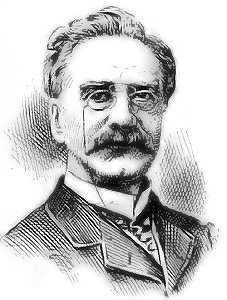Introduction

Born: February 17, 1842, York, England.
Died: June 11, 1922, New Jersey.
Buried: Cypress Hills National Cemetery, Brooklyn, New York.

Born: February 17, 1842, York, England.
Died: June 11, 1922, New Jersey.
Buried: Cypress Hills National Cemetery, Brooklyn, New York.
Peter was the son of Alexander Fraser Munro and Helen Miller, both natives of Scotland, and husband of Eugenie Louise Isabelle Testut (married 1865).
His family emigrated when he was 12 years old. After attending the Model School, Toronto, Canada, he studied oratory and dramatic art for three years. He began to learn the printing trade, but soon gave it up to enter the dramatic profession. He remained in drama several years, playing parts in various cities in the United Sates and Canada.
During the American civil war, he enlisted in the 34th Independent Battery of flying artillery, New York Volunteers, and served on Roanoke Island, North Carolina, and near Petersburg, Virginia.
After returning to New York, he yielded to the wish of his father, a Presbyterian minister, to give up the stage, and went into the printing business. Though he became an authority on the use of types and on typographical design, he was better known in America for his literary and historic abilities, and for his success as a teacher and lecturer.
In 1879, he became assistant editor of the American Model Printer, a pioneer technical periodical, published in New York City by Kelly & Bartholomew.
He was successively business manager of Thoughts and Events, a weekly journal of literature and affairs; chief editor of the Daily Financial Report; and chief editor of the American Art Printer. Meanwhile, he served as New York correspondent for a number of western and southern journals.
In 1892, he became editor of the American Pressman, a monthly devoted to the interests of the organized printing pressmen of the United States and Canada, who were then battling with the International Typographical Union for recognition as a separate an distinct branch of the printing trade. Munro later accepted the editorship of the Exponent, a society journal published in Brooklyn by John Suter.
For 35 years, Munro was also an instructor in elocution and dramatic art. Many prominent actors and actresses, clergymen, lecturers, and platform entertainers were trained in his Brooklyn studio of expression.
And, for over 30 thirty years Munro taught in Catholic schools, academies and colleges, including St. John’s College, Fordham; St. Francis Xavier’s College, New York City; St. Francis’ College, Brooklyn; the College of St. Angela, New Rochelle, New York; the St. John’s Boys’ Home, Brooklyn; and a number of parochial schools and literary unions where he was a teacher and director of entertainments.
He was also a professor of elocution in the Brooklyn Evening High Schools for three years.
He wrote a number of comedies, dramas and farces that were performed with varying success. In collaboration with his father-in-law, Dr. Charles Testut, he wrote the novel As Thyself.
A civil war veteran, Munro was, at various times, a commander in the Grand Army of the Republic (GAR), commander of the Department of the East in the Army and Navy Union of the United States, and in 1905 became president of the War Veterans and Sons’ Association.
And finally, Munro belonged to New York Press Club and the Thirteen Club.